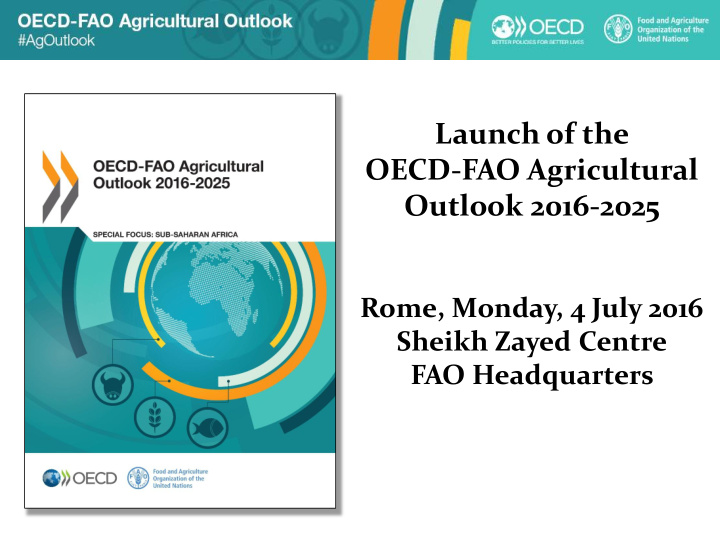



Launch of the OECD-FAO Agricultural Outlook 2016-2025 Rome, Monday, 4 July 2016 Sheikh Zayed Centre FAO Headquarters
Highlights of the Outlook • Food demand is expected to grow progressively slower but its composition will change • Global demand growth will be mainly satisfied through yield improvements • With supply and demand growth broadly matched, real agricultural prices are projected to remain relatively flat • Food imports into Africa, the Near East and Asia increasingly important for food security • We need to do more to meet the SDGs
Diverse consumption trends of major food groups 30% • Strong demand growth for meat, 25% Growth 2013/15 to 2025 fish and dairy products 20% • Food consumption of cereals stagnates 15% • 10% Shift toward livestock products induces additional need for feed 5% crops, particularly coarse grains and protein meals 0% • Strong increase in sugar and vegetable oil consumption Food Consumption Population
Production growth through intensification and efficiency gains, but regional differences AFRICA & NEAR AMERICAS EAST Yiel Yiel • Increase in demand projected Area d d to be mainly satisfied through 29% 71% 48% productivity gains • Large yield gaps in many developing countries Area 52% • Limited scope to increase EUROPE & ASIA & OCEANIA CENTRAL ASIA agricultural area sustainably Area Area • Slower yield growth expected 9% 9% in main producing countries Yiel Yiel d d 91% 91%
Market fundamentals point to stabilisation of real prices USD/T (Meat USD/T & Dairy) (Crops) • 5500 800 Prices to remain overall flat, but to change in relative terms 700 4500 600 • 3500 Relative price changes reflect 500 adjustments in the composition 2500 400 of demand and differences in 300 1500 supply conditions 200 500 100 • But need for vigilance - markets -500 0 remain subject to shocks that cause volatility and disruptions Wheat Rice Soybean WMP Beef and Veal
There is a substantial risk of a major price swing in the next ten years 80% probability range for maize price • Volatility from oil prices, economic growth, exchange rates and yield variations • Climate change will add to them • Policy-induced uncertainty not included but will compound volatility • A crisis more likely when the wrong policies compound volatility
Trade important for food security Regional net trade 150 Billions of Constant $2004-06 • Agricultural trade expected to expand, but at about half the 100 rate of the previous decade 50 • Global exports will be highly concentrated 0 • Imports more dispersed, but -50 China remains critical market • Increasing food import -100 dependency of resource poor regions Americas Asia Africa Others Note: Agriculture and fisheries products included in the Outlook
Sub-Saharan Africa: Outlook to 2025 190 • Total agricultural production is 170 projected to expand by 2.6% p.a., Index (2004-06 Base) an increasing share will come 150 from improved productivity 130 • Growth in food demand of more 110 than 3% p.a. expected, driven by population growth, leaving per 90 capita gains modest 70 • Need for imports is especially 50 high for vegetable oils (50%), 2000 2005 2010 2015 2020 2025 poultry meat (36%) and sugar (23%), all with an increasing trend Per capita consumption Total consumption Production
Sub-Saharan Africa: Key actions • Addressing low productivity of agricultural resources • Diversification and commodity dependence • Inclusive development • Resilience to climate change • Stable policies and institutions • Enabling environment for private investment • Expansion of intra-regional trade 9
We must do better! • Outlook maps out a most likely baseline. • Staying on this path would not eradicate hunger; but would reduce it from around 800 to 640 million. • The SDGs can only be achieved if rural poverty, food security and nutrition, sustainable agriculture and climate change are properly addressed by the global community. • Outlook confirms that we must do better and take action now to meet SDG2 by 2030. 10
Thank you for your attention For more information: EST-Projections@fao.org (Holger Matthey) TAD.Contact@oecd.org (Hubertus Gay) Or visit our web page: www.agri-outlook.org
Recommend
More recommend